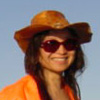Journal entries
Le Bon Journal
About
Search
Contact

Amazon.co.uk
Cloud Atlas
by David Mitchell
Paperback 544 pages (February 21, 2005)
Publisher: Sceptre
ISBN: 0340822783

Amazon.com
Bon Journal
Cloud Atlas by David Mitchell
David Mitchell's "Wolkenatlas", the Dutch translation of "Cloud Atlas", is number one on the book list of the Dutch paper "Het Parool." I am curious how the chapter of Zachary the Brave's narrative in a future dialect gets translated. That is the only chapter that I have trouble reading, despite English being my second language.
Having met the author and acquired his autograph on my new pink paperback of "Cloud Atlas" last Friday, I quickly found myself wishing that I hadn't caught the "snel trein" to Utrecht Centraal or thanking the additional 15 minutes of waiting for the next train to leave Utrecht after missing the last one by seconds. Soon I was cursing myself for becoming a slave to the book while secretly pleased about falling ill so that I could do nothing but lie on the couch and read.
As usual after reading dazzling reviews on the Internet and the book itself, I get a bit skeptical. What is all this hoo ha about? After meeting the author and his fans last Friday, I became convinced that I had to read the book.
The mystery begins --- there are six characters dispersed throughout time and across the world. How are they related?
The first chapter of Adam Ewing's diary offers no clue. In the second chapter, letters of a composer Robert Frobisher in Belgium, there is a mention of Adam Ewing's incomplete diary and a birthmark. This is the chapter I find most interesting, for I too aspire to compose and live among musicians. The third chapter, written like a novel, introduces a new character Luisa Rey who meets the recipient of Frobisher's letters. She too has the comet birthmark of Frobisher.
The author had read from an extract of the fourth chapter in his book-signing event in Amsterdam. It is probably the funniest selection. Later it emerges that Tim Cavendish's account of his ordeal became a movie watched by characters in the next chapter. The fifth chapter is an interview between an archivist and a clone. You have to read the sixth chapter out loud for it is written in a future dialect somewhat reminiscent of somewhere in the United States, although clearly it was set in Hawaii.
What is interesting is the way the author deliberately chooses a symmetric nested structure so that you have to read the entire book to see what happens to each of the characters. Each chapter until the middle of the book ends abruptly but returns in the second half of the book to continue the plot. The writing styles are wildly different, requiring a prolific writer to master the nuances.
Reading "Cloud Atlas" by David Mitchell made me realise what few literary works I've read in my life. Perhaps that's why I failed to appreciate the beauty of Shirley Hazzard's "The Great Fire" and failed to finish Monica Ali's "Brick Lane" which is still sitting on my shelf undigested.
4 February 2005 Friday
Related links:
analyticalQ personal book reviews
David Mitchell, the writer
David Mitchell at Oxygen - interview
Books on Japan - interview
Japan and my writing - essay by David Mitchell
Cloud Atlas - Salon.com review
Cloud Atlas - About.com review
Book World talks with David Mitchell
Parool book reviews - in Dutch
| Tell your friends about this Bon Journal entry: |
